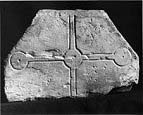Select a site alphabetically from the choices shown in the box below. Alternatively, browse sculptural examples using the Forward/Back buttons.
Chapters for this volume, along with copies of original in-text images, are available here.
Object type: Grave-marker [1]
Measurements: H.25 cm (9.8 in); W. 39.5 cm (15.5 in); D. 14 cm (5.5 in)
Stone type: Hartlepool and Roker dolomite
Plate numbers in printed volume: Pl. 18.89-91
Corpus volume reference: Vol 1 p. 52
(There may be more views or larger images available for this item. Click on the thumbnail image to view.)
A (broad): The horizontal arm of a type G1 cross, with a circular centre survives; the uprights, but not the terminals, of the other arms also survive. The cross is incised and has been laid out geometrically. The lines of the straight-edge and the holes for the compass points are still visible.
B and D (narrow): Uncarved and mostly cut away.
C (broad): A cross, type B6, with a ringed centre is carved in relief within a fine flat-band circular moulding. The mark of the compass point for describing the circle is still visible.
The ill-proportioned cross on A (compare 13) and the lack of a border set this apart from other early incised stones. It seems probable, as has been suggested (Morris 1974, 51), that the composition was never finished. It could have been contemporary with other slabs which bear this type of incised cross (see Lindisfarne 25-30, and Hartlepool 0 and 8), and merely be incompetent workmanship, or the cross could have been of the same date as the relief cross on the other side but a trial by a carver for whom such incised crosses were not a normal form. The other face, on which the arms of the cross are overlaid and enlaced by the ring, is competently done. The craftsman still uses a compass and chisel, but the encircled overlapping crossing of the centre seems a late fashion. Such a motif created by interlace is in the centre of Anglo-Scandinavian cross-heads at Aycliffe and Gainford.



